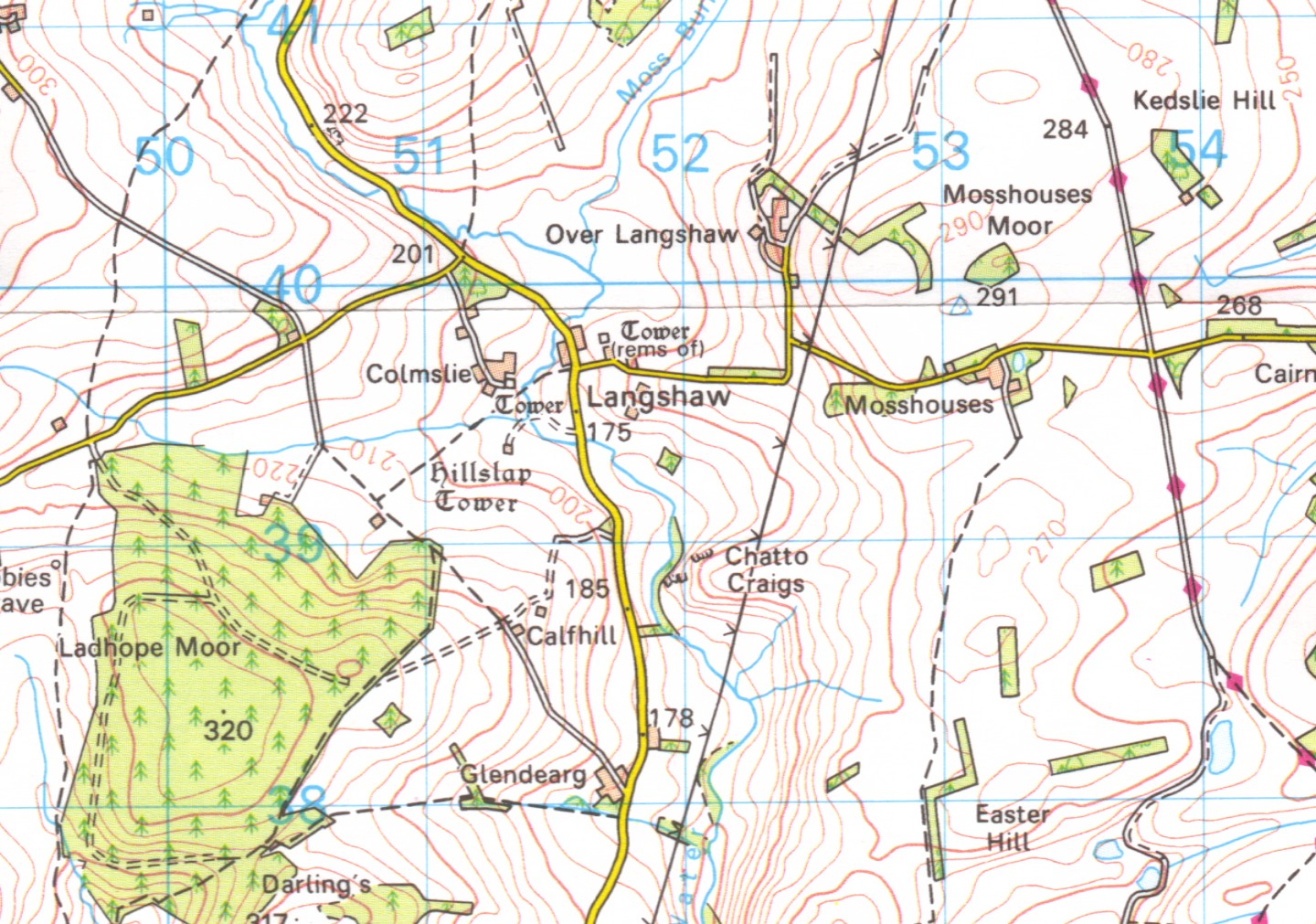
It is unusual to find three towers such as Colmslie, Glendearg and Langshaw built in such close proximity to one another. One might be tempted to say that they were built in such a position for mutual protection, except that a century or more separates the building of the one from the others. When we remember that they are built on the verges of three estates we are reminded of Sir William Borthwick’s explanation of why he built a tower at the edge of his estate: "We’ll breeze yont".
All the lands round about here were the property of the monks of Melrose until the Reformation. It would seem that when the shadow of the Reformation was threatening the tottering and corrupt church, the monks of Melrose were persuaded, either for a "consideration" or by pressure from above, that it would be advantageous for them to dispose of some of their lands to wealthy and powerful laymen, perhaps following the Scriptural injunction, "Make to yourselves friends of the mammon of unrighteousness."
The family which was to become closely associated with this area was apparently not native to these parts. We first hear of a Cairncross of Colmslie in 1538. This William Cairncross of Colmslie seems to have been connected with the Cairncrosses of Balmashanner, in Angus. The first of that family was John, who obtained the lands of Balmashanner on 28th October 1371.
The history of the family goes even farther back, for there is a certain Leod who was Abbot of Brechin and a lay lord at the court of King David I, who reigned from 1124-1153. The Abbacy of Brechin appears to have been a family possession, for the next three Abbots, Dovenald, Malise and John, appear as witnesses to Charters at various dates until 1219. John’s son Morgund does not succeed as Abbot of Brechin, but his son, Michael was the first to obtain the Cairncross lands in 1230, and it may be presumed that he would be the first to bear the surname Cairncross or Carnea Crux, meaning "a cairn surmounted by a cross." The line continues for many generations until we come to William of Colmslie (c. 1475-1555).
William was fortunate in having a brother, Robert Cairncross, who was a priest in the diocese of Melrose and held in succession the offices of the Provost of the Church of Corstophine, Abbot of Holyrood, Bishop of Ross and Abbot of Ferne, and was twice Lord High Treasurer of Scotland. Robert was evidently an astute ecclesiastic who arranged that his advancement in the church should be swift.
On 6 November, 1528 he was admitted a Canon Regular of Holyrood; five weeks later he was Abbot. He was elected Bishop of Ross on 14th April 1539, and on giving up the Abbacy of Holyrood he agreed to accept a pension from Holyrood of 500 marks Scots.
In 1529 and 1537 he was Treasurer to the King. In 1540-1 he was one of the Commissioners who held Parliament. He was admitted Abbot of Ferne in 1541, and in 1545 Queen Mary petitioned the Pope that Robert might be allowed to resign Ferne and that the Pope would admit thereto James Carnecors, Clerk of Glasgow, Robert, however, being allowed to retain the revenues. He died on 30th November 1545, and was buried in his Cathedral.
James Grant in "Old and New Edinburgh" states that "Robert Cairncross, one meanly descended, but a wealthy man, bought that preferment (i.e. the Abbacy of Holyrood) of the King, who then wanted money, eluding the law by a kind of fraud. The law was that ecclesiastical preferment’s should not be sold; but he laid a great wager with the King that he would not bestow the next preferment of that kind which fell vacant upon him, and by that means lost the wager but got the Abbacy." When Robert made his wager he knew that the reigning Abbot was dying.
We are not surprised to learn that Robert was able to persuade his former fellow monks at Melrose to give some of their lands to his brother William.
The branch of the family owning Colmslie parted with their estate sometime in the first half of the 17th century, and thereafter Colmslie rapidly and repeatedly changed hands until it came into the possession of the Innesses of Stow. It then passed into the possession of a Lady Reay, whose first husband was Alexander of Stow and Carolside, heir-at-law to the Innesses of Stow.
The name Colmslie is derived from St. Columba. A chapel dedicated to the saint once stood in a field to the east of the present farmhouse. The chapel is thought to have been built between the years 630-664 AD but no trace of it or of the graveyard surrounding it now remains. My wife’s great grandfather remembered seeing the last laird of Glendearg carried shoulder high over the water to his burial, which proves the existence of the graveyard as the burying place of the Cairncrosses.
On the front of the farmhouse there is a stone bearing the coat-of-arms of the Cairncrosses, which is the same as that of the Abbey of Holyrood - Argent ‘A Stag’s Head erazed and between the attiring or horns a cross crosslet fitchie surmounted on the top with a mullet gules. The motto is - RECTE FACIENDO NEMINEM TIMEO, "By doing right, I fear no one". This stone, and a sundial with the initials A. C., were removed from the old tower to their present position when the farmhouse was built. It would seem that Robert Cairncross, besides accepting a pension from Holyrood, also appropriated the coat of arms of the Abbey for the use of his family.
Colmslie is a square tower built of dark Silurian rock, with red sandstone facings at the corners and round the window openings, which are larger than one would expect in a tower of this date built largely for defence.
Glendearg was formerly called Calfhill, and the hill behind the tower still bears that name. Later it was called Hillslap, and finally was changed to Glendearg because of Sir Walter Scott’s reference to it by that name in The Monastery. Carved over the doorway are the initials N.C. and F.J., with the date 1585. These are the initials of Nicol Cairncross and of his wife, and the date when the tower was built. It is a typical tower of the period, in which the lower vaulted chamber has no connection with the rest of the tower. This chamber would be used as a storeroom or as a refuge for cattle in a raid. The entrance to the upper room is by a spiral staircase, part of which remains. These room as are of a good size, and well lighted according to the ideas of that time. The walls are built of Silurian, the windows, doorway and the corbel of a quarter round turret, of yellow sandstone, which is similar to that used in the oldest part of Melrose Abbey, and was probably brought from the same quarry at Maxton.
We can imagine what life would be like in such a tower at the time it was built. The large chamber on the first floor would be the hall, at whose fire most of the cooking for the household would be done. The floor of this room would be covered with rushes, and along the walls would be tables, which, at meal times would be lifted out and set up on trestles. A short table across one end of the room for the laird and his family, and the long ones down the length of the room for his servants and followers. There would be one chair for the laird, and stools for all the others. In the corners there would be stacks of arms, as this room served as an armoury. At night, while the laird and his family retired to sleep in the upper rooms, the men-servants would sleep fully clad on the floor of the hall ready for any emergency. As one purpose of such a tower was to act as a signalling station, there would be an iron fire-basket on the top in which a fire could be quickly lit as a signal to others of approaching danger.
These towers were designed to resist minor attacks. But, in the event of a major attack, it is probable that the occupants would drive off their cattle into the hills and themselves take refuge in a neighbouring town in such a house as Queen Mary’s house at Jedburgh, which was the town refuge of the Kers of Ferniehirst.
The last inhabitants of Glendearg were two old ladies who died on the same day. After their death five claimants came forward to press their claim, but after the expenses of the resulting lawsuit had been paid, there was very little left to distribute among the successful claimants.
Langshaw has probably bee a hunting seat rather than a tower. It dates from the time of James IV, who hunted in this area. At the reformation it came into the possession of the Pringle family, from whom it passed to the Baillies of Mellerstain.
I append a poem on Glendearg, written by my father-in-law, Rev. T. S. Cairncross:
"Gaunt, sequestered, blanched,
Naked it stands, unforgetful,
A star of old story,
Its red wistful, grey with age,
Its light a long shadow
Of time in the shafts of the sun;
And deep by the Elwyn
Where Carnea Crux passed over
To the chapel of latest resting,
Nothing but peace.
Hard by its ruins
Swords of yore have been gleaning,
That dared and feared no-one,
And over its quiet pastures
Sang the march of the armies of Scotland;
Ah! The red rain; where today sheep browse peaceful
On the fells of its Southland
All quiet now.
The
Abbot is gone
With book, stole , and vestment,
His name but a bed of flowers;
The Wizard who charmed him
Sleeps in his Abbey tomb;
Children of Dreams no more;
And o’er its antiquity
The runnel tinkles and chatters,
A thread of gold.
Nothing to me, all its lost
chapters;
Yet have I part in it all;
And since I am child
Of the Borders, and this border glory,
Shall I not honour
The name and the fame
In a garland of song?"
The above note was reprinted from the History of Berwickshire Naturalist Club, volume 24, pages 199/204 and was printed by Neil and Co. Ltd., 212 Causeway Side, Edinburgh. The date of printing is not quoted.
Area map showing Colmslie, Glendearg, Langshaw and Hillslap tower.

Here are some images. This one is Hillslap Tower.

This one is probably Glendearg Tower.
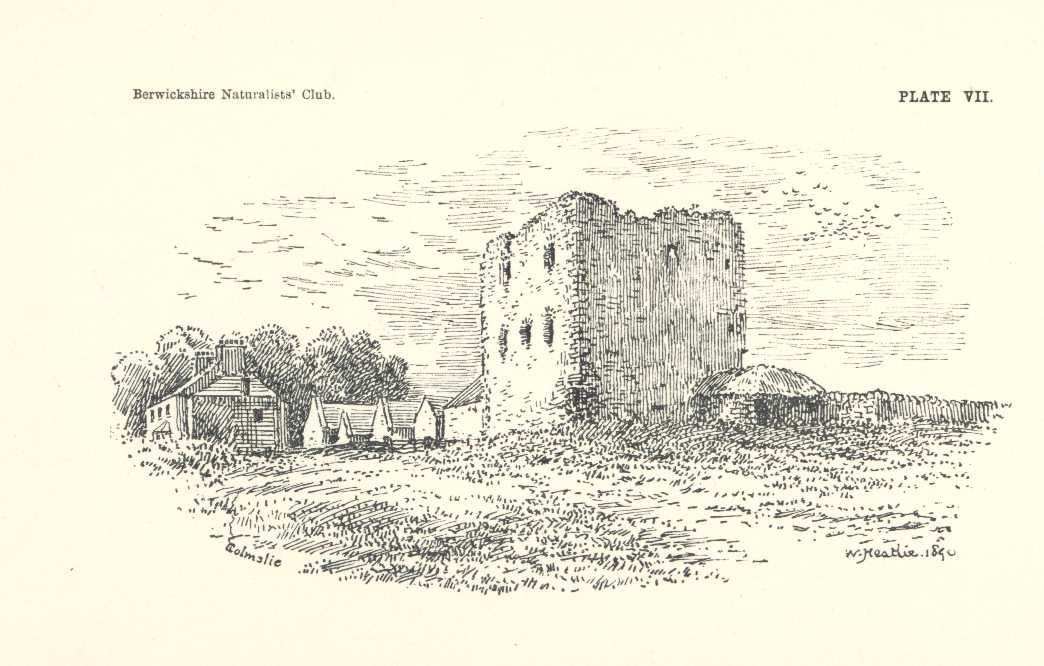
And here is another.
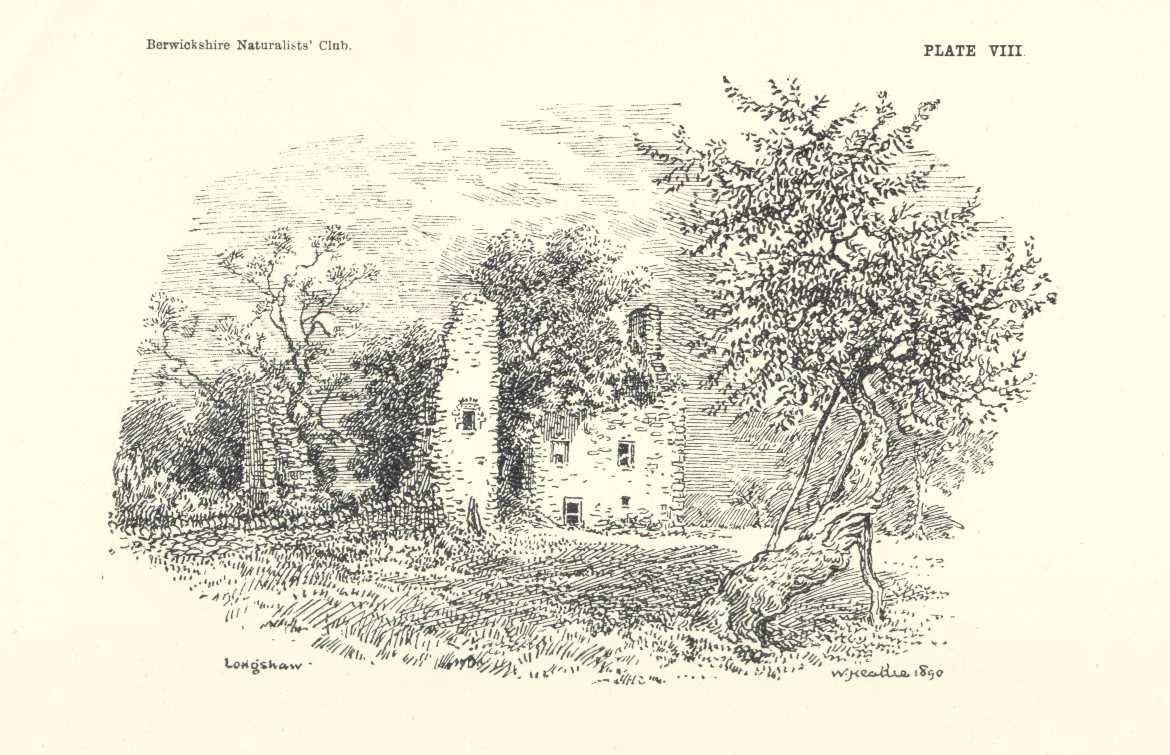
Here is a photo of Glendearg Tower.
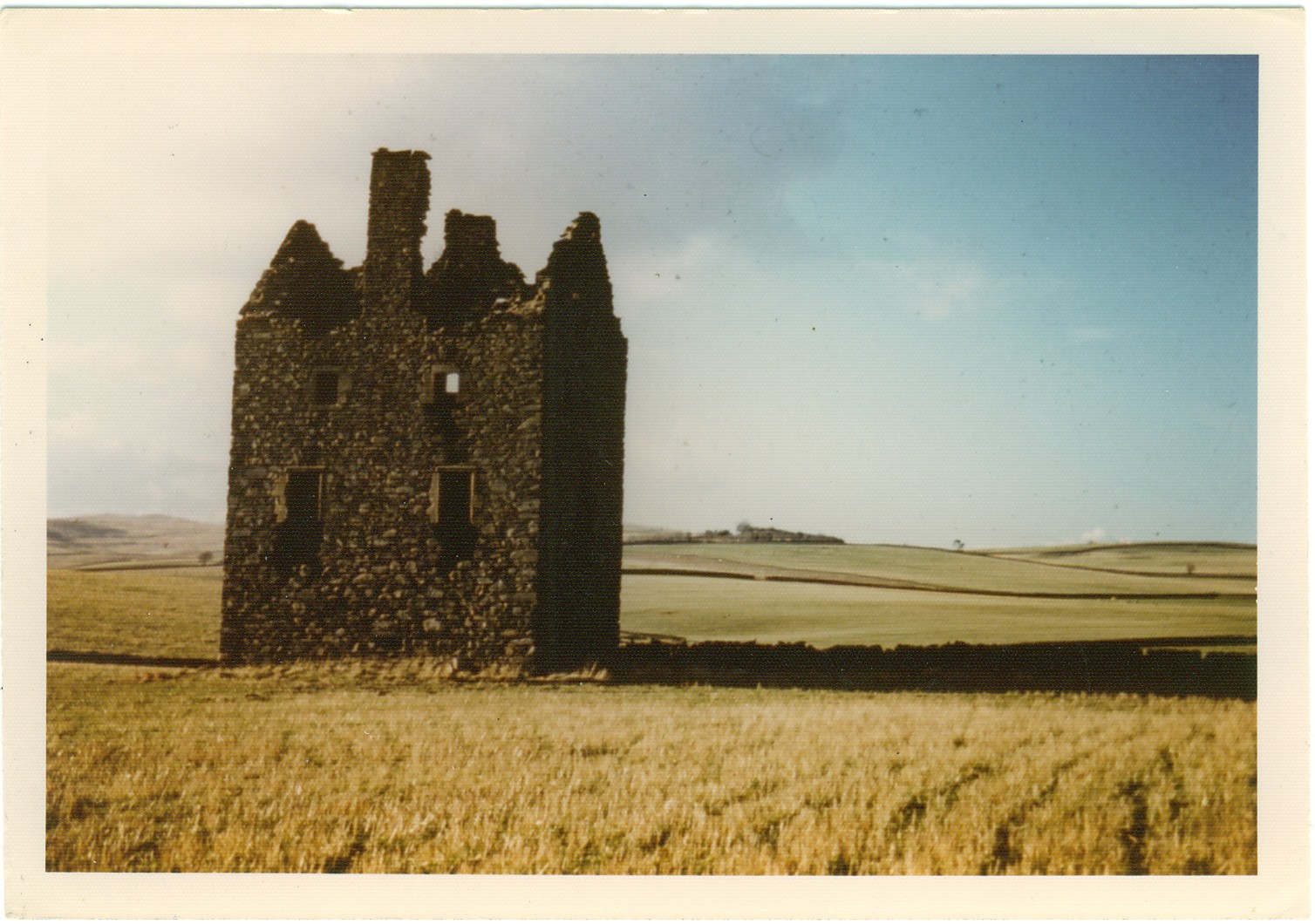
Nicky Cairncross-Jensen of Queensland has supplied another three images of Towers. Here they are:
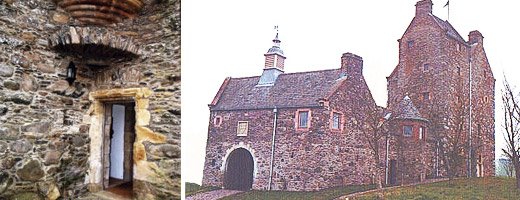
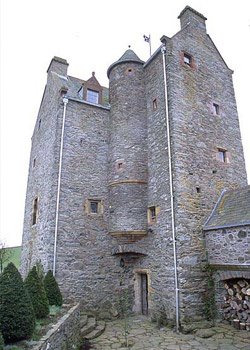

Click here to return to the front page.